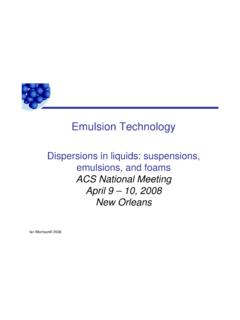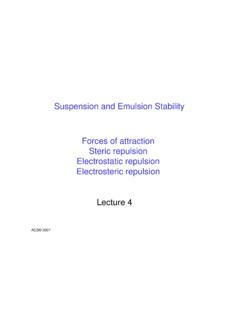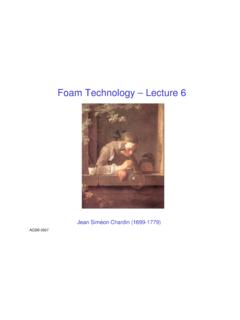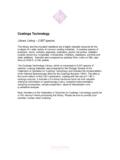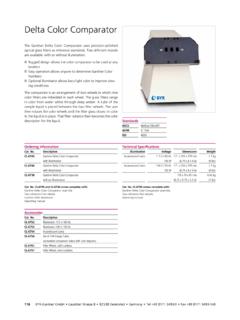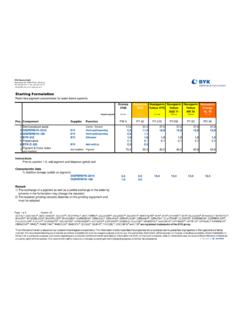Transcription of Dispersions in liquids: suspensions, emulsions, and …
1 Surfactant science and technology Dispersions in liquids: suspensions, emulsions, and foams ACS National Meeting April 9 10, 2008. New Orleans Ian Morrison 2008. Surfactant structure Air/Oil/Solid Hydrophobic portion Water Hydrophilic portion Ian Morrison 2008 Lecture 1: Surfactants 1. Adsorption lowers the energy At the air/ liquid interface: And the solid/ liquid interface: Lowers surface tension. Stabilizes Dispersions . Ian Morrison 2008 Lecture 1: Surfactants 4. Large volume aqueous surfactants Fatty alcohols and alkylphenol ethoxylates: R O R (OCH2CH2)nOH. R O. Alkanolamides: O. R CN OH. OH. Alkylbenzene sulphonates R SO3Na Fatty alcohol and fatty alcohol ether sulphates: R OSO3Na Ian Morrison 2008 Lecture 1: Surfactants 15. Oil-soluble surfactants Sorbitan mono-oleate (Span 80). O. S. O O. O. O. (O )n N Solsperse 17000.
2 N. O. S. O O. O. Polyisobutylene succinimide (OLOA 11000). Ian Morrison 2008 Lecture 1: Surfactants 27. Adsorption at interfaces Air-water surface Air-oil surface Oil-water interface Strong Little adsorption, Strong adsorption, little lowering of adsorption, substantial surface tension. substantial lowering of lowering of surface tension. interfacial tension. Ian Morrison 2008 Lecture 1: Surfactants 2. Adsorption by a solid surface The surfactant must be soluble in the liquid ! Solid-water interface Solid-oil surface interface The adsorption is driven by both strong The adsorption is tail/solid interaction driven by strong and entropy the head group/solid hydrophobic effect. interaction. Ian Morrison 2008 Lecture 1: Surfactants 3. Polymer adsorption Lost: polymer -solvent solvent - solid Gained: polymer solid solvent - solvent +.
3 Ian Morrison 2008 Lecture 1: Surfactants 33. Common polymeric stabilizers Aqueous Dispersions Anchor polymer Stabilizing moieties Polystyrene Poly(oxyethylene). Poly(vinyl acetate) Poly(vinyl alcohol). Poly(methyl methacrylate) Poly(acrylic acid) Napper, Poly(acrylonitrile) Poly(methacrylic acid). Poly(dimethylsiloxane) Poly(acrylamide) Polymeric stabilization Poly(vinyl chloride) Poly(vinyl pyrrolidone). Poly(ethylene) Poly(ethylene imine) of colloidal Poly(propylene). Poly(lauryl methacrylate). Poly(vinyl methyl ether). Poly(4-vinylpyridine). Dispersions ; Academic Press: New York;. Nonaqueous Dispersions 1983. Anchor polymer Stabilizing moieties Poly(acrylonitrile) Polystyrene Poly(oxyethylene) Poly(lauryl methacrylate). Poly(ethylene) Poly(12-hydroxystearic acid). Poly(propylene) Poly(dimethylsiloxane). Poly(vinyl chloride) Poly(isobutylene).
4 Poly(methyl methacrylate) Cis-1,4-poly(isoprene). Poly(acrylamide) Poly(vinyl acetate). Poly(methyl methacrylate). Poly(vinyl methyl ether). Ian Morrison 2008 Lecture 1: Surfactants 39. Ionic surfactants If the organic tail is not too large, the surfactant dissolves in water and dissociates into an anion (negative) and a cation (positive): O. O S O Na+. O. The highly charged Some of the anions remain in solution. ions are completely solubilized. O. O S O. And some of the O. anions are adsorbed at surfaces. Ian Morrison 2008 Lecture 1: Surfactants Adsorption of ionic surfactants At the air/water interface: At the solid/water interface: Charges the particle and Lowers surface tension. stabilizes the dispersion . Ian Morrison 2008 Lecture 1: Surfactants 5. Adsorption of nonaqueous surfactants At the air/oil interface: At the solid/oil interface: Little effect on surface tension.
5 Stabilizes the dispersion . Ian Morrison 2008 Lecture 1: Surfactants 6. Etymology English Greek Latin English meanings are not literal translations, but interpretations oil lipo- oleo- of how the words are water hydro- aqua- solvent lyo- solvo- understood in this branch of both amphi- science. flow rheo- affinity -philic Technical terms (neologisms). lack-of-affinity -phobic are formed by combinations of nature -pathic these words, such as the science -logy following adjectives: amphipathic = combining both natures (oil and water understood). amphiphilic = with affinity for both (oil and water understood). hydrophilic = with affinity for water lipophilic = with affinity for oil lyophilic = with affinity for the solvent lyophobic = lack of affinity for the solvent Ian Morrison 2008 Lecture 1: Surfactants 12. Classification of surfactants Anionic The surface-active portion bears a negative charge Alkane carboxylic salts (soap).
6 Alkane sulfonic salts (detergents). Alkyl-aromatic sulfonic salts Others: Phosphates, phosphoric salts Cationic The surface-active portion bears a positive charge Amine salts Quaternary ammonium salts Zwitterionic The surface-active portion bears both charges Long-chain amino acid salts Betaines Nonionic The surface-active portion contains no charge Long chain ethers Fatty acid esters Amides Ian Morrison 2008 Lecture 1: Surfactants 13. Where do I start? Surfactant suppliers providing on-line help Byk Chemie Schibley Chemical Surfactants, Inc. Surfactant manufacturers providing on-line help Akzo Nobel Arizona Chemical BASF Cognis DeForest Enterprises Dow Corning McIntrye Group Rohm and Haas Updated 03/08. Ian Morrison 2008 Lecture 1: Surfactants 11. Solsperse Surfactants Ian Morrison 2008 Lecture 1: Surfactants 7. From Byk Chemie Low MWs Ian Morrison 2008 Lecture 1: Surfactants 8.
7 From Byk Chemie High MWs Ian Morrison 2008 Lecture 1: Surfactants 9. From Byk Chemie Media Properties Ian Morrison 2008 Lecture 1: Surfactants 10. Micelles and liquid crystals Surfactants self-associate at higher concentrations Ian Morrison 2008 18. Surfactants create their own surfaces . Adsorption and micellization are competing processes. Ian Morrison 2008 Lecture 1: Surfactants 21. A lower limit in surface tension sucrose ~ soap concentration of solute The surface tension drops but reaches a limit. Ian Morrison 2008 Lecture 1: Surfactants 19. Other limits in surfactant properties The critical micelle concentration - cmc. 10. Detergency Density change 8 Conductivity Arbitrary units 6. Surface tension 4. Osmotic pressure 2. Equivalent Interfacial tension conductivity 0. % Sodium dodecyl sulfate Ian Morrison 2008 Lecture 1: Surfactants 20.
8 Solubility of ionic surfactants - The Krafft Point Note: the rapid increase in solubility Concentration Crystals Micelles of the surfactant at a critical temperature. CMC curve The increased solubility is due Solution to the formation Krafft point Solubility of micelles. curve Temperature Ian Morrison 2008 Lecture 1: Surfactants 26. Solubilization above the CMC. Solubility of 2-nitrodiphenylamine in aqueous solutions of potassium laurate. 5. 4. 2. Solubility gL x 10. 3 The solubility of gas increases sharply after 2 micelles form (at the CMC). 1. 0. 0 1 2 3 4 5 6 7 8 9. Percent potassium laurate Ian Morrison 2008 Lecture 1: Surfactants 22. Effect of temperature on solubilization in nonionics Fix the temperature, add heptane. Solubilization of n-heptane in 1% aqueous solutions of POE( ) nonylphenyl ether (I) and PEO( ) dodecylphenyl ether (II).
9 Filled circles are cloud points. Open circles are solubility limits (Rosen, p. 188). Ian Morrison 2008 Lecture 1: Surfactants 23. Oil surfactants form inverse micelles The micelle core is highly polar. The diameters are 10's of nanometers. Ian Morrison 2008 Lecture 1: Surfactants 28. Electrical charges in nonpolar media liquid Conductivity Half-time ( -1cm-1) (sec). Highly purified 10-17 12,000. hydrocarbons Light distillates 10-16 to 10-13 1,200 to Crude oil 10-11 to 10-9 to Distilled water 10-6 x 10-6. Ian Morrison 2008 Lecture 1: Surfactants Charge/mass ratio in oil A sample of carbon black Sample dispersed in oil with OLOA. 17000 is put on a filter. Electrometer A flow of pure oil through the dispersion c urrent removes all the countercharges! time Ian Morrison 2008 Lecture 1: Surfactants Charge separation in inverse micelles Coulomb Energy of Attraction 0.
10 The Coulomb attraction 1. between oppositely alkane e0. charged ions in water is 78. e0. water much less than in oil. Energy (units of kT). 2. 3 Therefore ions in oil must be prevented from 4. coming too close together. 5. 0 10 20 30 40 50. Separation (nm). Ian Morrison 2008 Lecture 1: Surfactants Conductivity vs concentration Conductivity of OLOA 17000. in dodecane ( 25o C ). 100. 80. Conductivity (pS/cm). 60. 40. = * concentration 20. 0. Concentration (wt %). Ian Morrison 2008 Lecture 1: Surfactants Charging of particles in oils 150. 125. Conductivity (pS/cm). (b). 100. (a) Without particles. 75. (b) With particles (a). 50. 25. 0. Concentration of OLOA 1200 in dodecane (wt%). Ian Morrison 2008 Lecture 1: Surfactants Surfactant phases Nicola Pinna, Max Planck Institute of Colloids and Interfaces Ian Morrison 2008 Lecture 1: Surfactants 25.

